In early April 1982, Argentina invaded the Falkland Islands, a few desolate rocks in the South Atlantic. The British mobilized their fleet in response. The carriers arrived off the Falklands on May 1st, swiftly defeating the Argentine Air Force. The Argentine Navy tried to interfere the next day, but withdrew after the cruiser General Belgrano was sunk by a submarine. Two days later, the Argentinians struck back, sinking the frigate Sheffield with an Exocet missile. Two weeks later, on May 21st, British troops landed at San Carlos Water on the west coast of East Falkland. The Argentine Air Force quickly got wind of this, and launched numerous sorties against the invasion fleet. The first three days were brutal for both sides, with the British losing two frigates and suffering several others damaged, while a third of the Argentine jets were shot down.1
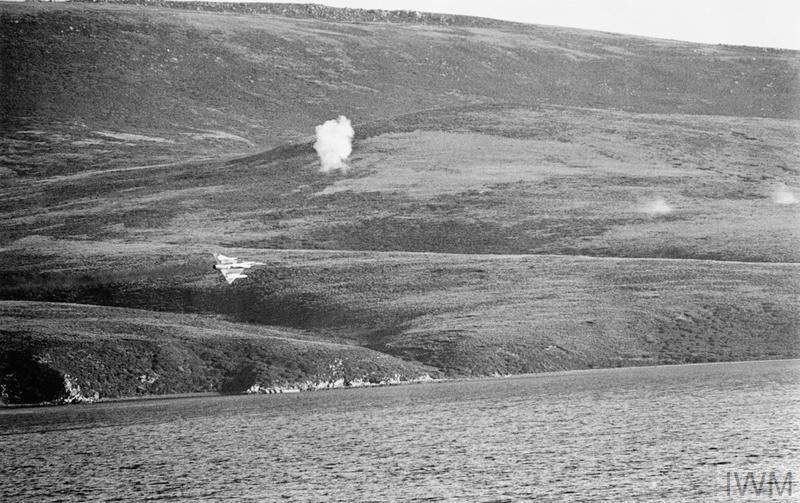
An Argentinian Dagger flies low over San Carlos
Despite the battering that the escorts had taken, the amphibious shipping itself remained largely unmolested throughout the first three days at San Carlos. The attackers, approaching from the north and west, had dissipated their efforts against the frigates in Falkland Sound, which while expensive and annoying wasn't actually enough to disrupt the landing. To break up such raids before they could reach the landing area, Broadsword and Coventry were stationed to the north. Unfortunately, this concentrated two of the three available long-range air-search radars away from the amphibious group, while the third, aboard the damaged Argonaut, was hemmed in by the ridgelines of San Carlos. None of them could cover the southern sector, which the Argentinian commanders, aware of their lack of success, had decided to make use of. Aircraft hugging the ridgelines could arrive at the head of San Carlos Water with little warning, hopefully getting away before the defenders could respond.
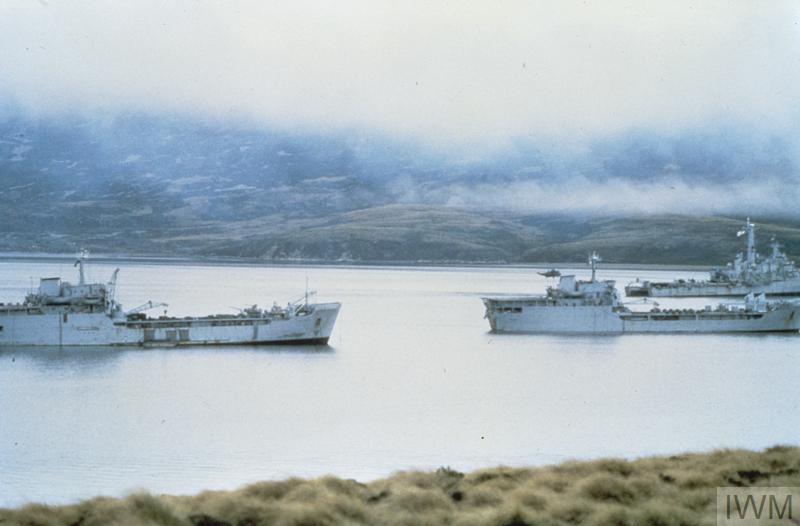
LSLs, with Sir Lancelot on the left
The first raid of five Skyhawks was spotted by Paras in the Sussex Mountains at 0945, only moments before they descended on the line of LSLs2 anchored near Ajax Bay. Sir Galahad and Sir Lancelot were both hit, although as usual the bombs failed to detonate and merely started fires. Another hit Sir Bedivere's crane and glanced off, exploding in the sea nearby. Another bomb struck near Fort Austin. All of the Skyhawks escaped, although several returned with damage.
The next raid, this one of four Daggers, was only 20 minutes behind. The Paras were able to give more warning, and the jets were greeted by a great deal of fire from Rapier, Seacat, and automatic weapons. Fearless and Sir Galahad were strafed, but the only ship hit by bombs was Sir Lancelot. Fortunately for her, the Daggers had no better luck with their fuzes than the Skyhawks had, and her crew continued to battle the fires. The ineffectiveness of the Argentine bombs was matched by the British air defense weapons, as all of the Daggers made it home despite serious damage.
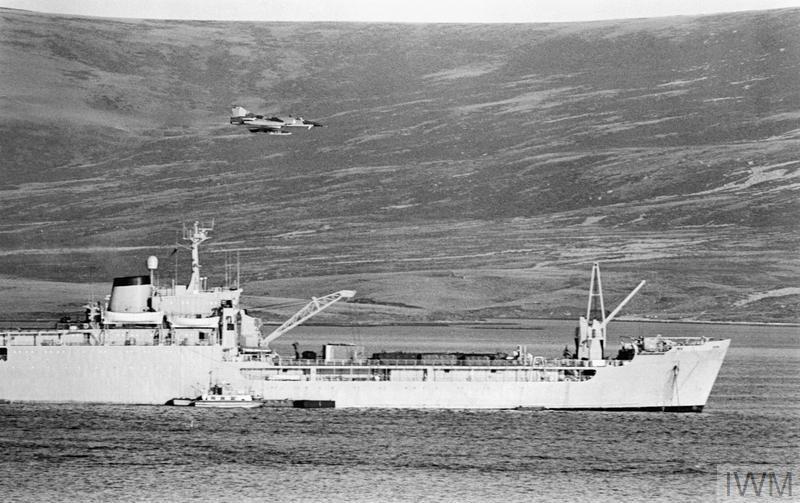
A Dagger flies past Sir Bedivere
Even as the fighters fled San Carlos, another quartet of Daggers was inbound. Unlike the previous two raids, this one was approaching from the north. Broadsword and Coventry promptly picked it up and vectored in the Sea Harrier CAP, who settled in on the Argentine fighters' tails. Two Sidewinders from the lead Harrier found their targets, sending the Daggers into the drink. The second British pilot managed to tag a third with another missile before the last Argentine aircraft broke away and headed home at low level. Two of the downed pilots ejected safely, although the third was killed.
Hard on the heels of this engagement came the third attack from the south. A trio of Skyhawks were greeted with such intense fire that no hits were scored on any of the ships, and one of their number was downed, apparently by a man-portable Blowpipe missile. Another suffered so much damage that it began leaking fuel, and had to be "towed" home by a C-130 tanker, while the third also suffered damage.
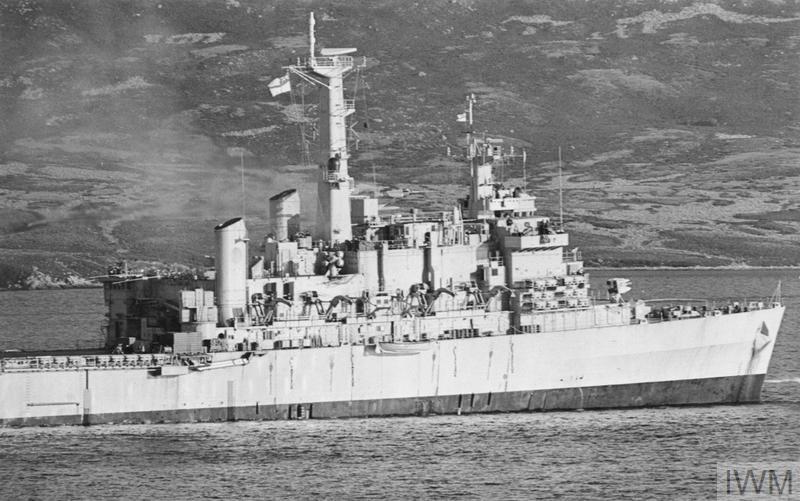
HMS Fearless under air attack. A Dagger can be seen between the masts.
The Chinese among the crews of the two damaged LSLs were quickly evacuated,3 and the rest of the officers and men got the fires under control. All three bombs were quickly and safely defused, although Sir Lancelot was damaged badly enough that it took several days to repair her, and she served as a barracks ship and helicopter pad in the meantime, logging 3,342 helicopter landings during the Falklands Campaign as a whole.
The information that most Argentine fuzes were failing to set off their bombs should have been a tightly-kept secret, but the British media got wind of it and the BBC, continuing its policy of "Broadcast and be Damned" (presumably by the men in the Falklands) announced on May 23rd that there were ships in San Carlos with unexploded bombs onboard. Admiral Woodward was rightly furious, and managed to clamp down on such reports, although sadly the journalists escaped any consequences for their behavior. Fortunately for the British, the Argentinian arsenal did not appear to contain fuzes that could be made to work in these circumstances.
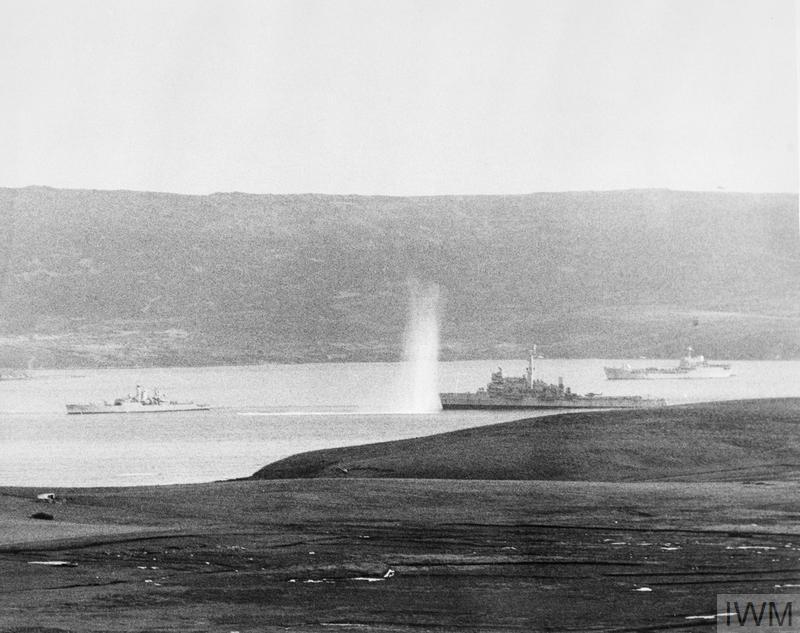
A bomb explodes in the water near Fearless
May 25th was Argentina's national day, and it was expected that they would make a major effort. At around 0200, several ships reported noises on the outside of their hull, and anti-frogman procedures were swiftly initiated. It turned out to be a false alarm, but the ships were repositioned anyway, which also gave better protection against air attack. That morning, a group of Skyhawks appeared over West Falkland. Broadsword and Coventry picked them up, and a Sea Dart from Coventry took care of the leader, with the other pilots turning for home without attacking. Another raid turned for home when VYCA-2 picked up Harriers being vectored to intercept. The last air attack on the ships in San Carlos came later that morning, when a quartet of Skyhawks appeared from the south at around 1130. One was downed by a Rapier, and the pilot, the first Skyhawk flier to survive being shot down, also became the first to be taken prisoner by the British. All of the bombs fell well clear of the repositioned transports. One of the other aircraft was shot down by a Sea Dart from Coventry on the way home, and enough damage had been done that one of the survivors required a tow home from the tanker. The battle for San Carlos was over, and the British were firmly ashore.
Unfortunately, this victory was matched with a defeat. May 25th saw several attacks on ships outside of San Carlos, and the British took the worst losses of the entire campaign from them. We'll examine these next time.
1 For more information on ships and aircraft, as well as links to the whole series, see my Falklands Glossary. ⇑
2 Landing Ships Logistics, ships designed to carry troops and supplies. ⇑
3 The Royal Fleet Auxiliary, as the civilian-manned support force to the RN, recruited most of its hands (the equivalent of enlisted men) from Chinese communities. I'm not sure exactly which ones, but I'd guess that it was probably places like Singapore and Hong Kong, not mainland China. ⇑

Comments
I'm kind of astonished that the BBC got away with stuff like that. It seems like the sort of thing people would have gotten hanged for in WW2.
Well, there was the May Incident.
"the Argentinian arsenal did not appear to contain fuzes that could be made to work in these circumstances"
Does this mean their fuses were intended for attacking land targets?
IIRC from earlier in the series, the issue with the fuses was the minimum arming time was too long for bombing runs at the altitude the Argentines preferred. The American solution to this problem was to fit devices to slow the descent of the bombs, but the Argentines did not seem to have these.
I am a bit surprised that a timed fuze was not an option. It seems like that would have been fairly easy to fabricate in a pinch (although it's not like they had an excess of time to work with.)
Did they have any rockets? Regular old unguided rockets would seem to be effective with the attack profiles they were using, and while I doubt they would sink any frigates with rockets, they might kill the officers on the bridge and damage the radar systems, maybe set the ship on fire, etc.
I believe the Argentinians were in possession of Zuni and 105mm Pucaras rockets, but they weren't used in the anti-shipping attacks. The Argentinians also had retardation kits for their Mk 82s, but the extreme low level attack profiles didn't allow the bombs to slow down while still in flight.
I wonder if sending in a wave of low-level planes to hit the ships with Zunis – hopefully knocking out their SAMs or at least presenting a more urgent target – and then following it up with properly-delivered bombs would have been a better strategy, then. I think that HVARs were used to sink lightly armored ships during WW2, so 105mm rockets might have done a lot of damage.
Of course, the bombs might have been less accurate if they weren't being dropped at point-blank range – I don't know how sophisticated their fire control was.
Not to belittle the Argentinian aviators, who seem to have shown a lot of guts and ingenuity throughout the conflict! But I like thinking through counterfactuals.
The counterfactual that springs to my mind is: if the Argentinians had bombs that went off, might they have won? It seems that several more British ships would have been lost, or at least crippled.
I haven't been doing the math, but just from reading through the series it seems like if their bombs had detonated reliably, it might have changed the outcome. It seems like quite a few ships survived a bombing and kept fighting, and every ship that was lost really seems to have cut down on the English air defense network. If a few more escorts get sunk, it seems like eventually the Argentines start sinking English transports and killing off the ground invasion force.
To be fair, the Argentines seem to be taking a lot of losses, so the end result might have crippled their air force even if they knocked out the major British surface escorts, which probably would still result in a British victory?
Of course I guess the British could have just camped a submarine offshore and sunk every Argentine ship until they reconsidered their actions...
First, on the specifics of the fuzes, they were apparently all equipped with a WWII-era US vane fuze, which would spin as it flew and only be armed if it had spun enough. A retarded bomb makes the vane spin slower. At the low altitudes the bombs were dropped at, there wasn't enough time. Fabricating a better fuze isn't that hard, but it takes time and effort, but the last three parts span only five days, and there just wasn't time to fix the problem.
The problem with rockets is doctrine and training. They already had trouble with people dropping bombs on ships who weren't used to it. I don't know how many of the pilots were good with rockets, or what airplanes could safely carry them. Changing military doctrine takes time, and the Falklands were over too fast for much of that.
To mangle Clausewitz, politics is the continuation of war by other means. If the British suffer a humiliating public defeat, then they're done. Thatcher's government falls, a peace treaty is hastily signed, and Argentina gets new islands. Even if an SSN can interdict traffic to them.
So I'm interpreting this as: In WW2, the Americans bombed from high altitudes and designed their fuses accordingly. In the 40 years to the Falklands war, anti-aircraft weapons and sensors developed to the point where this was now suicide, so low level ground hugging attacks were mandatory. The Argentine Air Force never did much low level training, at least not with live weapons, and so never noticed that doctrine required new, or at least adjusted weapons. British weapons were ALSO not quite matched up to the sort of fighting they were encountering, but the mismatch wasn't quite as bad.
I think that they had planned for higher-level attacks, but the fear of British air defenses pushed them down lower than their doctrine called for, and ruined the fuzes.
Could Argentinian ammo technicians have given the fuze vanes ~half the required number of turns by hand? The bombs go on the planes non-armed (even accounting for manufacturing inconsistency), but they arm sooner after release.
Probably not. Fuzes are usually designed to fail safe, and you really don't want a plane getting blown up because someone accidentally spun the fuze a few too many times before they loaded it. Mike might know more if he's paying attention.
Air Force planes did not have bombs for ships. Naval aviation did have it, and they were prepared for these tasks, that is why they used 4 bombs instead of 1 or 2.